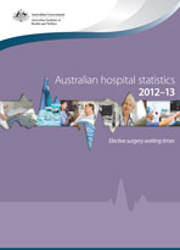Summary
How much elective surgery was there in 2012-13?
In 2012-13, Australia's public hospitals admitted about 673,000 patients from elective surgery waiting lists (as either elective or emergency admissions).
Almost 1 in 4 of these patients was admitted for General surgery (surgery on organs of the abdomen) and about 1 in 7 was admitted for Orthopaedic surgery (surgery on bones, joints, ligaments and tendons, including knee and hip replacements).
Between 2011-12 and 2012-13, admissions for elective surgery increased by 1.8%. The Northern Territory and Western Australia had the highest increases (7.7% and 3.9%, respectively).
Elective surgery admissions per 1,000 population increased by an average of 1.2% per year, from 28.0 per 1,000 in 2008-09, to 29.4 per 1,000 in 2012-13. These numbers are not adjusted for changes in the number of hospitals reporting over this period.
Between 2008-09 and 2012-13, admissions for Cataract extraction increased by an average of 5.9% each year and admissions for Total knee replacement increased by an average of 5.5% each year.
How long did people wait for surgery?
In 2012-13, 50% of patients waited up to 36 days for public elective surgery, an increase over the 33 days in 2008-09 and unchanged since 2011-12. The median waiting time ranged from 27 days in Queensland to 51 days in the Australian Capital Territory.
The median waiting time was shortest for Principal referral and specialist women's and children's hospitals (35 days). It was 38 days for Large hospitals and 45 days for Medium hospitals. The surgical specialties with the longest median waiting times in 2012-13 were Ophthalmology, Ear, nose and throat surgery and Orthopaedic surgery (76, 68, and 65 days, respectively). Cardio-thoracic surgery had the shortest median waiting time (17 days).
C oronary artery bypass graft was the procedure with the shortest median waiting time (16 days). Septoplasty and Total knee replacement had the longest median waiting times (197 days and 196 days, respectively).
The amount of time within which 90% of patients were admitted for the awaited procedure increased from 219 days in 2008-09 to 265 days in 2012-13.
Between 2008-09 and 2012-13, the proportion of patients who waited more than a year to be admitted for their surgery was relatively stable at around 3%. In 2012-13, the national proportion of patients who waited more than a year was 2.7%.
Ear, nose and throat surgery and Orthopaedic surgery were the surgical specialties with the highest proportion of patients who waited more than 365 days (5.9% and 5.5%, respectively). Cardio-thoracic surgery had the lowest proportion (0.3%).
Septoplasty and Total knee replacement were the procedures with the highest proportion of patients who waited more than 365 days (15.7% and 12.1%, respectively).



